In the last few years, we’ve seen the fitness tech market explode with a plethora of wild new products. From smartwatches and other wearables to apps designed for everyone from gym rats to yogis, we’ve seen it all—and then some.
Our team aimed to create a new approach to a healthy lifestyle. The app includes a wide range of workouts, marathons, and fitness challenges which make this app address crucial social issues. Our goal was not only to make people healthier but to help organizations to hold their charity events. The app follows the best practices of user experience and the recent trends to address and solve the common user pain points.
Please visit our Behance page for more information about the fitness app case.
Project Timeline
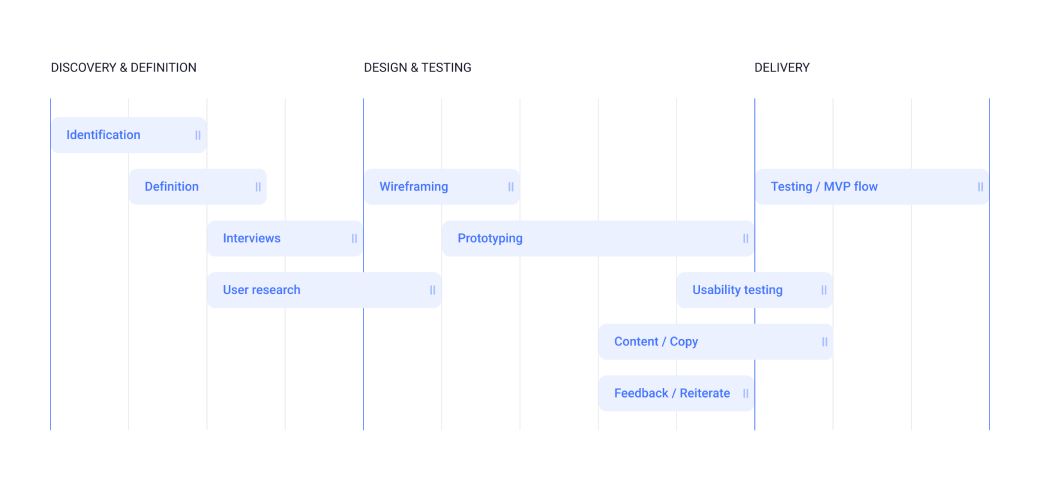
Let’s briefly discuss the project timeline, before we jump into the UI-UX design of this case. The project timeline was divided into three phases:
1. Discovery and definition. This is a preparation stage of the project. During this phase, we framed the project idea, identified the main project triggers, and work on competitor analysis. Our research aimed to find out major user pain points and frustrations while using fitness apps. So we could improve the user experience and the logic of such apps.
Conducting the interviews with the targeted audience we found out potential users’ needs and wishes. As a result, it helped us incorporate our findings into the product development strategy. The final element at this stage is the framing of User Research. In other words, constructing the portrait of the targeted users based on market research and our findings. User Research slowly flows into the next phase of the project.
2. Design and testing. After we know the portrait of the potential users we start Wireframing and Prototyping. Wireframes help to show the general application scheme. We placed the main data based on user research to make the user experience a meaningful one. Then to test how the app works and how users will interact with it we created prototypes. In fact, from low-fidelity to fully-interactive models, prototypes are great to show design ideas.
At this stage, we created content for the app and received the first feedback so we knew which direction to move and what to improve in the app. Then comes Usability testing, it’s all about getting real people to interact with an application. From our side, we observed users’ behavior and reactions to it to make sure we built an effective and enjoyable experience for the users.
3. Delivery. The Agile software development implies the app got tested at every stage of the process to make the product better. So, this phase is particularly about testing and improving the existing product based on the feedback from the first users.
Employing test with real users helps us to:
Validate the prototype. Bring users early enduring the development process and test their reactions before launching the final product. This provides answers to whether users understand what was the purpose of the app. Testing on a prototype first can validate the concept and help to make plans for future functionality before spending a lot of money to build out a complete product.
Confirm that the app meets expectations. Once the product is completed, test usability helps to make sure everything works the way it was intended and check if something is still missing in the interface.
Identify issues with complex flows. Usability testing makes the process as straightforward as possible and helps to identify the parts of the user journey that need to be simplified. For example, if there are functions on the app that need users to follow multiple steps?
Complement and illuminate other data points. Usability testing can often provide the why behind data points accumulated from other methods: a heat map might show that people aren't paying attention to an important part of the landing page, but observing users in action can reveal why they're ignoring it.
Catch minor errors. In addition to large-scale usability issues, usability testing can help identify smaller errors. A new set of eyes is more likely to pick up on broken links, site errors, and grammatical issues that have been inadvertently glossed over. Individually, these incorrect details may not matter a lot, but, collectively, they contribute to the perception of a site's professionalism and trustworthiness.
Ultimately provide a better user experience. A great customer experience is essential for a successful product. Usability testing can help you identify issues that wouldn't be uncovered otherwise and create the most user-friendly product possible.
Fitness App Idea and Challenges
Do you have a fitness app on your mobile phone? If yes, we are not surprised. After the fitness boom of the Apple Watch in 2015, more and more people have become more aware of their health and body shape. Because of this, the industry of fitness applications continues to grow. There are many apps aimed at different aspects of our everyday life from eating healthier food to working out.
While there are many competitors, the niche of fitness applications remains prospective. Do you want to develop a fitness app and get your market share? Then, you are on the right path to success.
Problem. The lack of motivation is the no.1 reason why a lot of people don’t work out. Even if a person is motivated to start his journey to a healthy lifestyle, it's hard to find an effective online personal trainer.
That is why the idea was to create a unique app for workout routines and fitness training programs. After revealing all the pain points that exist on the market we decided to implement the social feature to make a more meaningful impact on the fitness app. So, besides regular training programs, we added different types of challenges like charity workouts, marathons. The idea was to create charity events that came from social issues around the world. Our goal was not only to make people healthier but to help organizations to hold their charity events and eventually combine business and user goals.
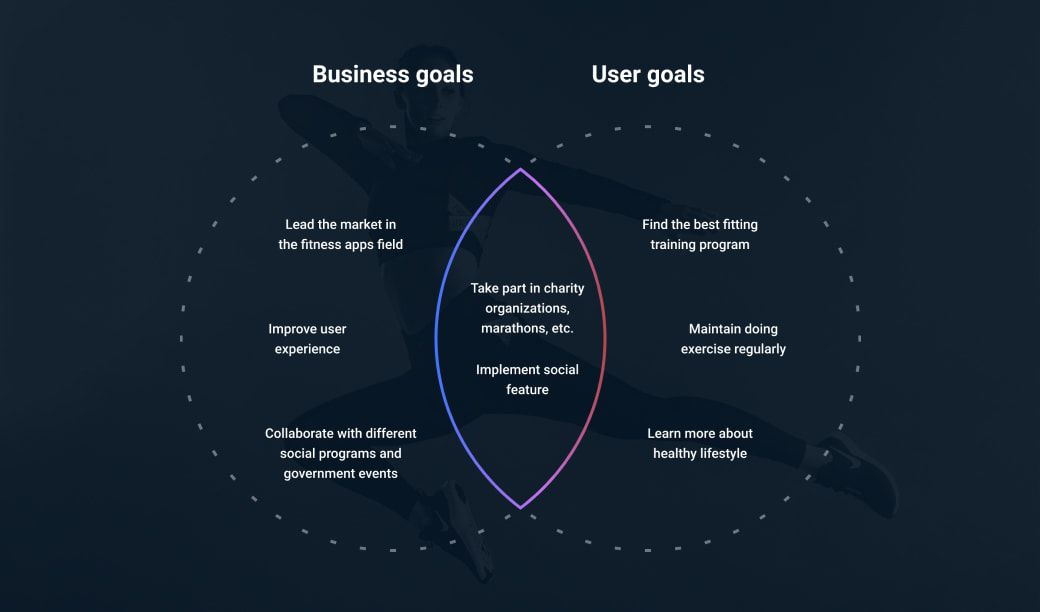
Using the design-thinking approach we found the balance between business goals, user needs, and modern technological solutions to achieve the best results in product development. The most important thing was to frame precise goals that we wanted to achieve during the research phase.

There were a few main challenges that we tried to solve with our fitness application:
Build an application with different online workout programs for everyone;
Motivate users to stay physically active by fitness challenges and sports podcasts;
Create an extensive database with training programs;
Create a detailed activity monitoring system to track progress;
Implement gamification and competitive excitement.
User Personas
Creating user personas is a great method to understand the users’ needs, experiences, behaviors, and goals more clearly. In our case with the fitness app, we tried to think of fictional characters (based on the user research we made) to represent the different user types that might use our app.
User personas help you to recognize that different people have different needs and expectations, and it can also help you to identify with the user you’re designing for. Personas make the design task at hand less complex, they guide your ideation processes, and they can help you to achieve the goal of creating a good user experience for your target user group.
Creating user personas often involves three steps:
Gathering data about your users;
Putting the data together;
Creating your user persona.
Before you begin gathering data about your ideal users, you should first ask yourself three crucial user questions which eventually will help you plan and shape your user persona research:
Who is my ideal user?
What are the current behavior patterns of my users/potential users?
What are the goals and pains of my users?
As a result, we come up with such user personas:
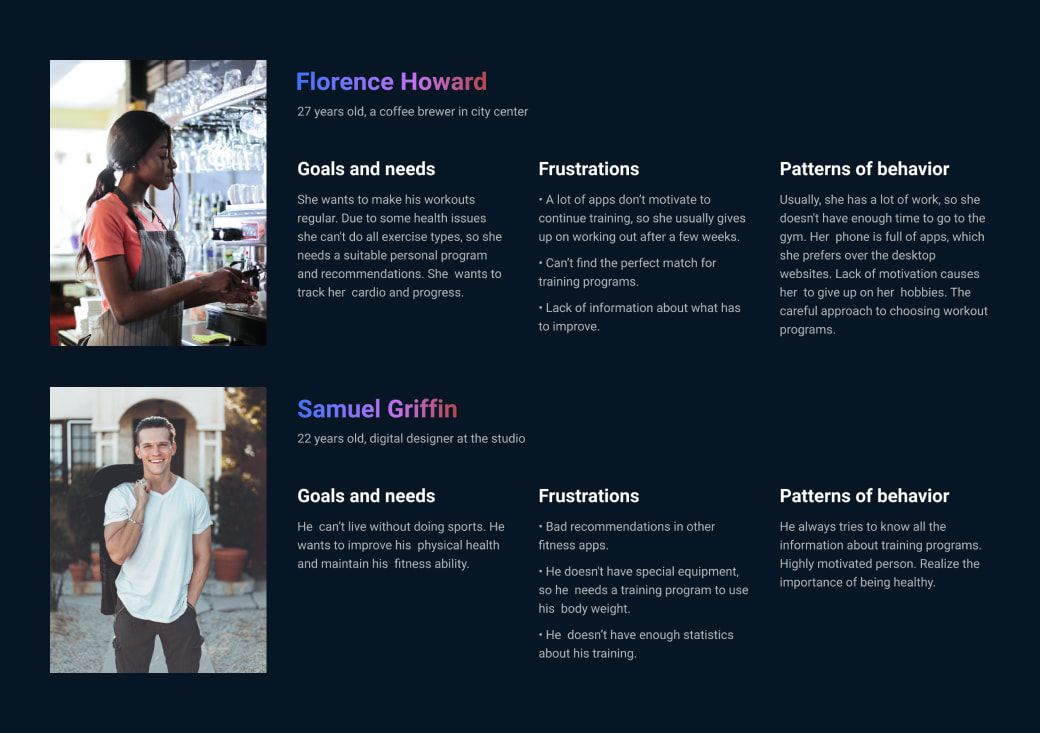
Visual Identity
Creating an exquisite and intuitive visual design that makes use of the aesthetic usability effect to proffer a pleasing experience. The reason for considering yellow color was because a warm variant of yellow is known to stimulate mental activity and generate muscle energy.
In order to establish a connection with the user, the typeface should be perfectly arranged following the best practices of spacing, color, size, hierarchy.
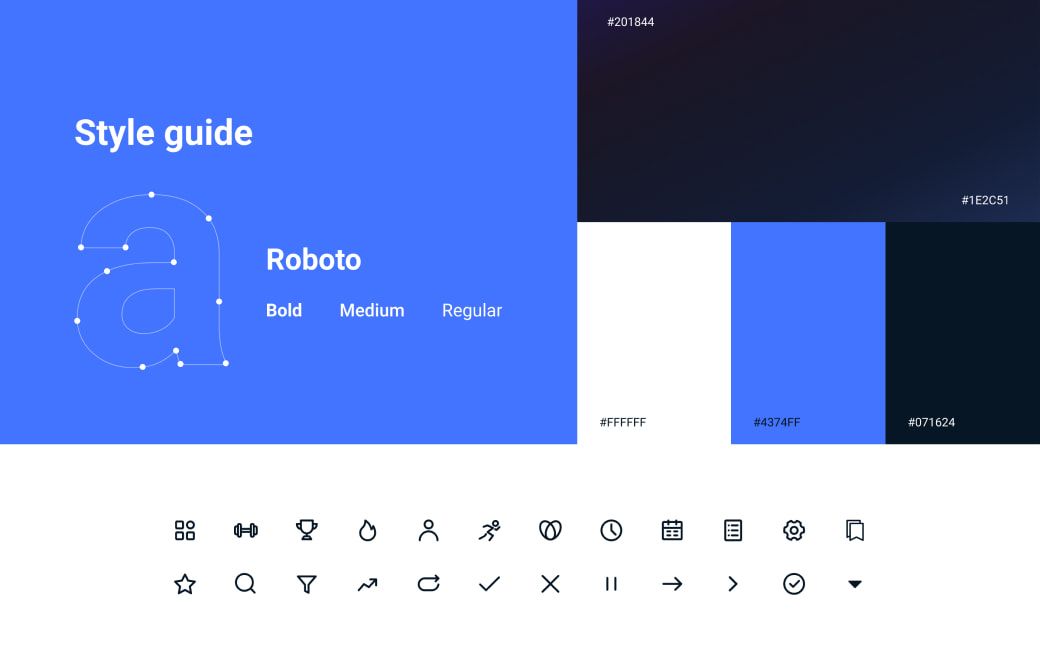
User Flow
User flow describes the steps that users take to access a function or perform a task in your app. Each click, swipe, and drag-hold is part of user flow. Even in simple apps, flow is an important part of the UX — in fact, it can hold the key to the app’s appeal. That is why one of the main tasks was to analyze and organize all the incoming information to visualize content blocks and features.
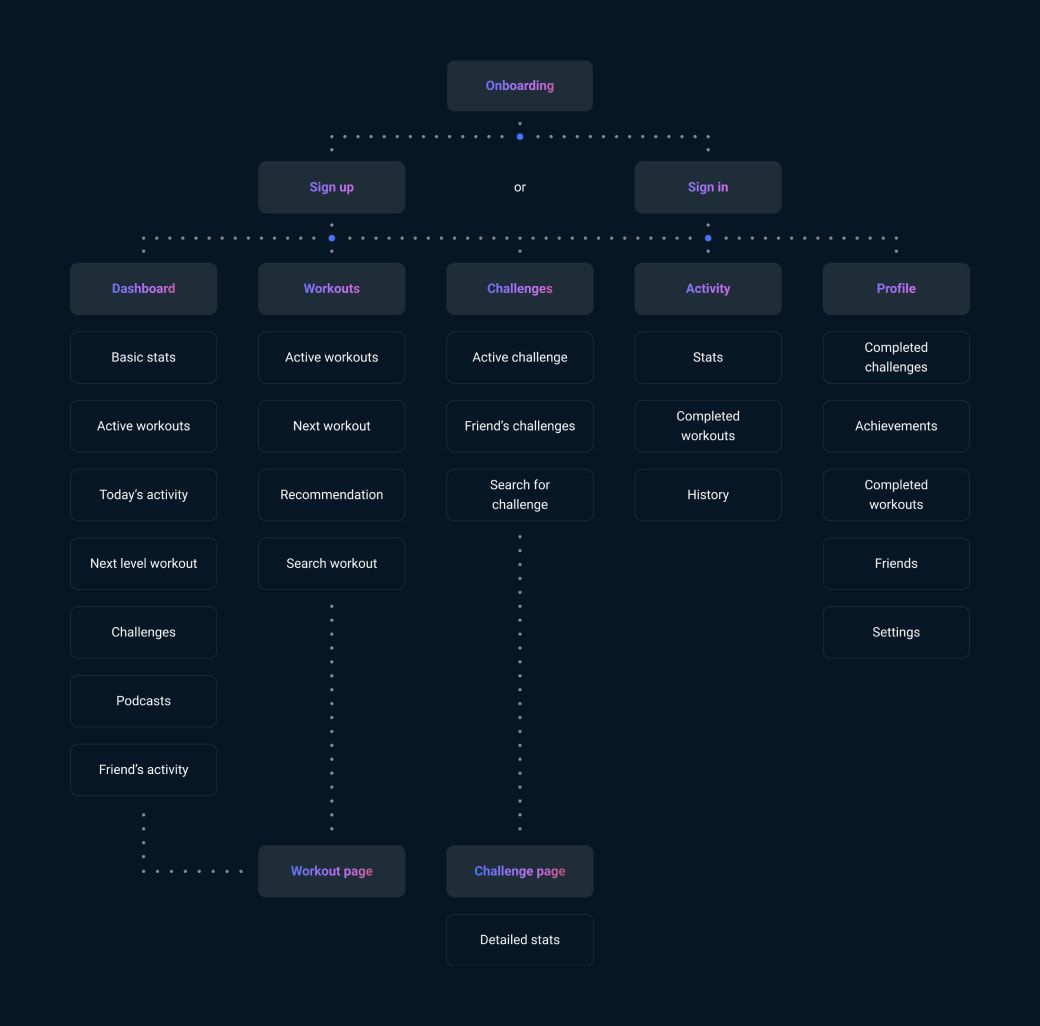
Mobile app development is often a complex balancing act between functionality and usability. On the one hand, you want users to be able to easily access the most important functions of your app without a lot of extra steps. That means big, easy-to-tap buttons available from the main screen. On the other hand, there’s probably far more depth to your app than you can squeeze into a few buttons. We tried our best to make the app as user-friendly as possible.
How Does the App Work?
To make your own fitness app, you need to think about its features. When building digital products from scratch, it makes sense to build an MVP first. MVP stands for a minimum viable product. Its features will help you understand whether your product is useful for clients and how you can improve it in the future.
In this section, we’ll go through all MVP features for a fitness app.
Registration
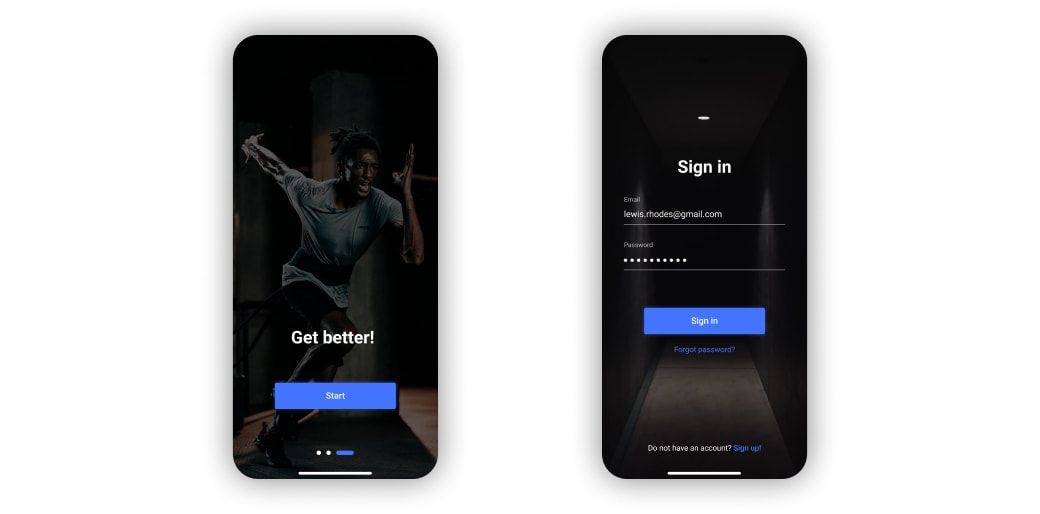
Registration is an essential process for the majority of apps. It may be non-obligatory if your app is a simple step tracker. However, if you provide unique training or meal plans, then users should always register. Registration lets you get more user data and make their experience with the app more personalized.
User Settings
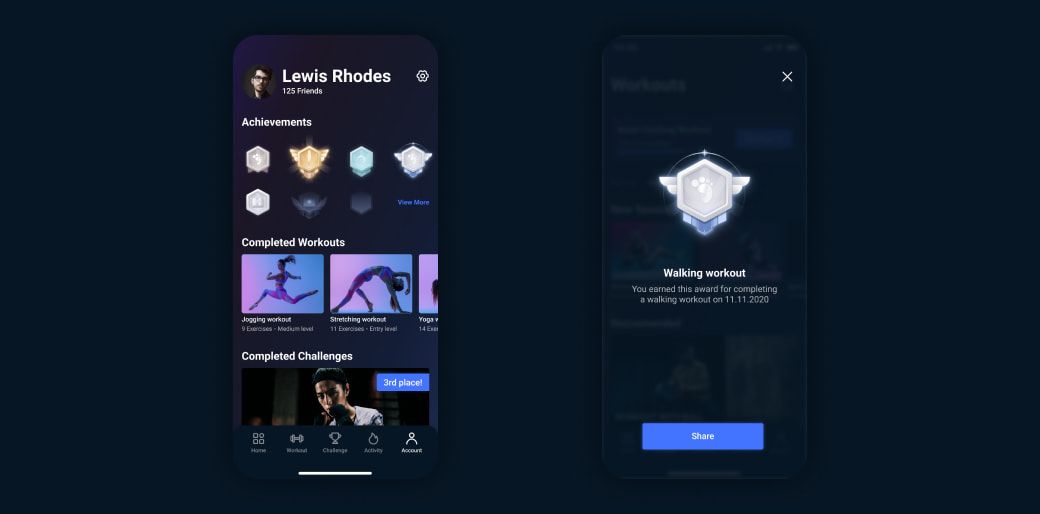
How to create a fitness app with a personalized approach? First of all, let users manage their personal physical information. Data like height, weight, age, and other parameters help to create personal workouts and achieve results faster. Besides, you can reward users with interactive badges for their achievements. They can find rewards in their profiles.Moreover, upersonal profile should include “Achievements” section where user can track completed workouts and challenges and view the points/achievemnts for completed tasks.
Integration With Wearable Devices
Devices like fitness trackers, smartwatches, heart rate monitors, smart scales, and others give even more statistical data for your app. On top of that, you can make a fitness app for wearable platforms in the future. Thus, users can leave their cell phones at home and get the same app features on their smartwatches.
Workout Menu
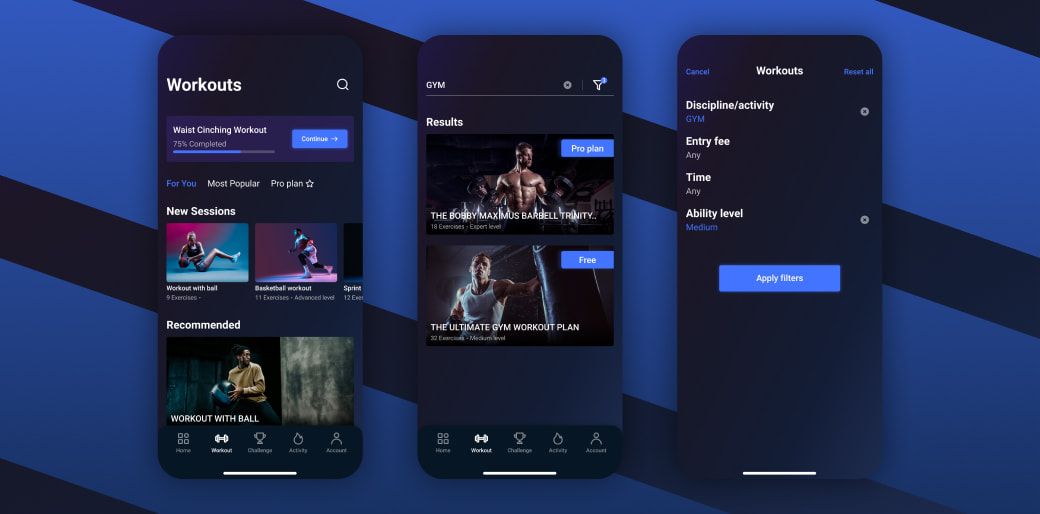
The main purpose of fitness apps is to track physical activity, so workout screens are obligatory. Menus can differ depending on the app type, but the idea remains the same. For example, smart fitness coach apps will have a menu with workout options and a video explaining how to perform the exercise. At the same time, the activity tracking app displays the time spent on the training and real-time statistics of the session.
When developing a fitness app, take care of a minimalistic and intuitive menu. Users should be able to easily find the exercises they’ve performed during their workout.
Integration With Third-Party Apps
A single app with MVP features can’t be a jack-of-all-trades in terms of fitness. To extend the abilities of your app, you have to sync it with other workout and health applications. For example, your app calculates the number of calories burned after the workout. In turn, the third-party diet app provides data about the consumed meals and your app calculates the lack or surplus of daily calories.
Synchronization with platforms like Apple Health and Google Fit helps to make a fitness app that determines the level of physical activity based on the user’s heart rate. As for the nutrition apps, smart sugar-measuring devices help to draw up a proper diet plan.
Statistics
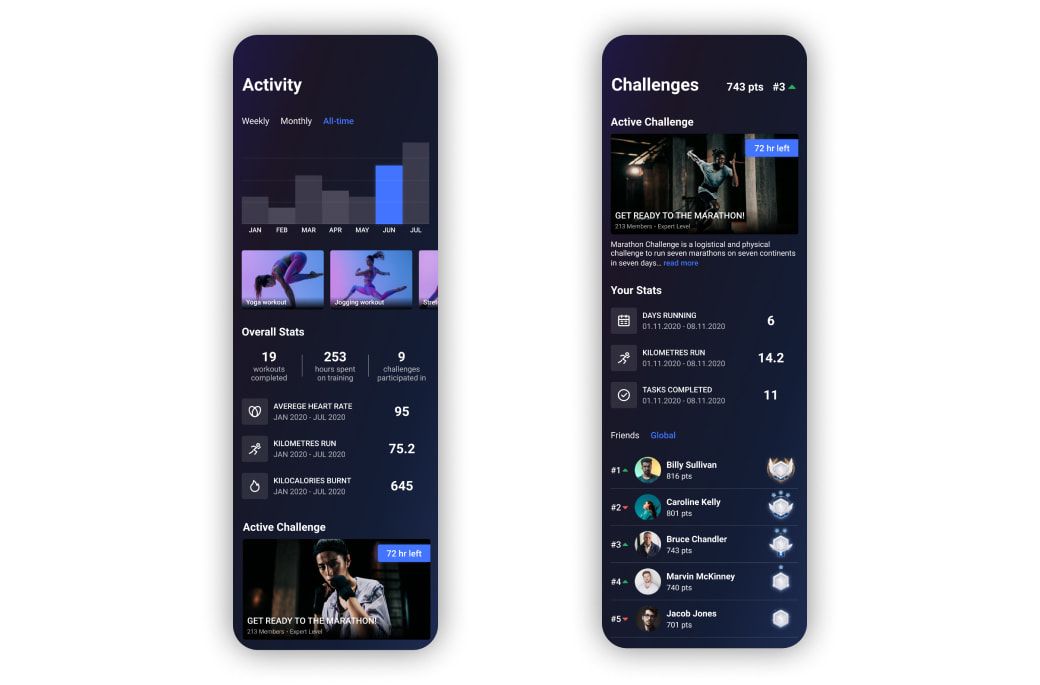
Detailed statistics help users understand their progress when they can’t notice visual changes. There are two types of statistics:
Global. It displays global progress for a chosen period of time (week, month, year). These stats are useful to track the changes in users’ weight, muscle mass, and training intensity.
Local. It’s a short-term statistics that help users track the progress from one training session to another. Local stats show running pace, cadence, travel distance, heart rate, and so on. With these stats, sportspeople can monitor their performance during each workout.
Build a fitness app representing stats in the form of charts and diagrams, rather than in a pure text form. Visualization makes post-training analytics more engaging.
Fitness Database
Without regard to the app type, it should have a large fitness-related database. If you’re building a diet app, give users a choice of products to add to their ration. If they can’t find particular meals in your app, they’ll probably abandon it and start looking for alternatives. The same thing concerns workout app development. The apps should deliver a wide choice of exercises, explain their influence on a body, and make clear how many calories users will burn during the workout. A large exercise database is obligatory so that users could work on different muscle groups and create diverse training plans. If your app doesn’t have enough content, it’ll be hard to retain users.
Community and Leaderboards
To engage users in sports and motivate them to use the app, you can add a bit of competition. Create a fitness app with competitive leagues for users. Depending on the progress, they’ll compete with each other to enter into a more advanced league. Users get points when they complete training sessions and exercises — those who have the most points at the end of the season advance to the next league. You can reward users with unique badges or even give them a monthly premium membership.
Such gamification leads to the creation of a strong community of users. So, it makes sense to create a forum where experienced athletes give advice on how not to lose motivation, perform exercises, and choose sports equipment.
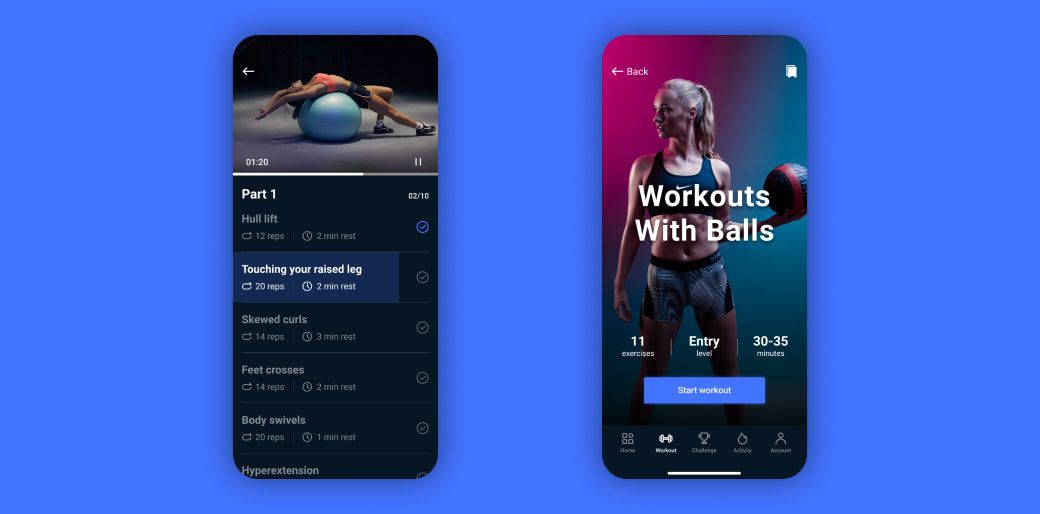
Features That’ll Help You Stand Out
To make a workout app unique and more customer-focused, you can upgrade it with more sophisticated features. Let’s go through the advanced features and study some examples.
Coach-on-Demand
Apart from group training, users can arrange a personal session with the coach for an additional fee. During the live stream, users learn new exercises and adjust their training plan together with the coach. It’s even possible to book a coach for a long period, but the app should have a schedule. Thus, it’ll be easier for coaches to manage their clients.
Live Streaming or Video-on-Demand
To fully understand the technique of the exercise, users might want to watch a video. There are different ways to solve this issue. The first one is live streaming. Professional coaches may organize a group training where users connect to the session and repeat all exercises after the coach. The pros of this approach are that people can gather into groups of dedicated fitness enthusiasts. They may consult a coach and discuss fitness techniques together. On the contrary, live sessions take place according to the timetable. It may be inconvenient for some users.
Another option is to create a fitness app with video-on-demand workouts. Users download videos and follow the pre-recorded instructions. Even though they have no real communication, coaches can create polls after the training to learn the difficulties that users experienced. The main advantage is that the video is always available, so users don’t have to adapt their routine to the training.
Barcode Scanner
Filling the diet app with meals and products has its own drawbacks. If there are too many items in the database, the navigation and search process will take more time. Users don’t want to wait too long, so you have to come up with additional solutions while developing a fitness app.
A barcode scanner can add the product to the daily ration just with the help of the smartphone’s camera. It’s a convenient feature because it doesn’t only detect the product but also identifies a manufacturer. That’s how users can get full information about their meal in several seconds.
You can use machine vision algorithms for those products that don’t have a barcode (fruits, vegetables). The device identifies the food based on its shape, color, and size. However, this approach requires you to hire AI developers, which often charge a lot.
Check out Top App Design Companies
Integration With Social Media
It’s always exciting to share your achievements with friends. To build your own fitness app with social interaction features, you can use social media integration tools. They help users to make an instant post about their progress in sports. Users can pair the text from the app with an attractive picture to get a fine post to their profile. Besides, you can make this feature beneficial for your product. Simply add the name of the app or even a link to it. That’s how users will promote it for free on their social media.
Conclusion
Fitness application development can be quite a challenging task. But now that you know how to build a fitness app, we hope it will be easier for you to estimate the cost of your idea.
Thus, your solution should have the best fitness app features such as personal account, setting goals, actual activity tracking, and social elements. The app can offer a custom workout plans creation feature. Also, it's an excellent idea to collaborate with as many wearable producers as possible (and cost-efficient).
Looking for a designer to visualize your idea? Our creative team will bring your idea to full-fledged responsive design and create eye-catching website design and development. If you have any questions, we’ll be more than happy to help you build top wellness, fitness, or eHealth brands.





